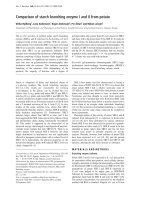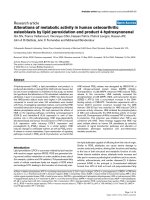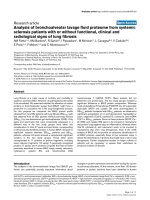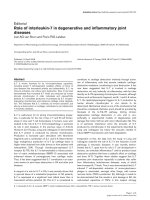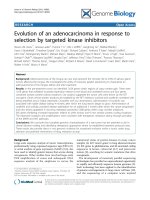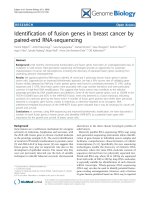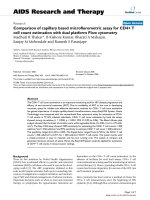Báo cáo y học: "Comparison of prevalence of metabolic syndrome in hospital and community-based Japanese patients with schizophrenia" potx
Bạn đang xem bản rút gọn của tài liệu. Xem và tải ngay bản đầy đủ của tài liệu tại đây (276.12 KB, 8 trang )
PRIMARY RESEARCH Open Access
Comparison of prevalence of metabolic syndrome
in hospital and community-based Japanese
patients with schizophrenia
Norio Sugawara
1,2*
, Norio Yasui-Furukori
2
, Yasushi Sato
1,2
, Ikuko Kishida
3,4
, Hakuei Yamashita
5,6
, Manabu Saito
2
,
Hanako Furukori
7
, Taku Nakagami
2,8
, Mitsunori Hatakeyama
9
and Sunao Kaneko
2
Abstract
Background: Lifestyle factors, such as an unbalanced diet and lack of physical activity, may affect the prevalence
of metabolic syndrome (MetS) in schizophrenic patients. The aim of this stu dy was to compare the MetS
prevalence between inpatients and outpatients among schizophrenic population in Japan.
Methods: We recruited inpatients (n = 759) and outpatients (n = 427) with a Diagnostic and Statistical Manual of
Mental Disorders, fourth edition (DSM-IV) diagnosis of schizophrenia or schizoaffective disorder from 7 psychiatric
hospitals using a cross-sectional design. MetS prevalence was assessed using three different definitions, including
the adapted National Cholesterol Education Program Adult Treatment Panel (ATP III-A).
Results: The overall MetS prevalences based on the ATP III-A defi nition were 15.8% in inpatients and 48.1% in
outpatients. In a logistic regression model with age and body mass index as covariates, being a schizophrenic
outpatient, compared to being a schizophrenic inpatient, was a significant independent factor (odds ratio = 3.66
for males, 2.48 for females) in the development of MetS under the ATP III-A definition. The difference in MetS
prevalence between inpatients and outpatients was observed for all age groups in males and for females over
40 years of age.
Conclusions: Outpatients with schizophrenia or schizo affective disorder in Japan had a high prevalence of MetS
compared to inpatients. MetS in schizophrenic outpatients should be carefully monitored to minimize the risks.
A change of lifestyle might improve MetS in schizophrenic patients.
Introduction
A high prevalence of metabolic syndrome (MetS) has
been reported among schizophrenic patients [1-3]. Me tS
has been r elated to an increased risk f or cardiovascular
diseases [4,5], diabetes [6] and mortality [7] and is
defined as a cluster of metabolic disturbances including
abdominal obesity, a therogenic dyslipidemia, hyperten-
sion and hyperglycemia [8].
Commonly used definitions for MetS are the National
Cholesterol Education Program Adult Treatment Panel
(NCEP AT P III) MetS definition [7] and the adapted NCEP
ATP III (ATP III-A) definition, proposed by the American
Heart Association (AHA) following the American Diabetes
Association’ s(ADA’s) lowering of the threshold for
impaired fasting glucose to 100 mg/dl [9]. Because abdom-
inal obesity is widely recognized as a measure of metabolic
abnormality, the International Diabetes Federation (IDF)
established a definition that stressed the importance of
waist circumference [10]. However, the small physique of
the Asian population made it dif ficult to use the same waist
circumference criterion determined for those of European
descent [11]. Therefore, modified criteria for waist circum-
ference (90 cm for males and 80 cm for females) have been
proposed for Asians in the ATP III-A [ 12] and IDF [13]
definitions. In addition, a definition established by the
Japan Society for the Study of Obesity (JASSO) [14] was
also used in this study. Based on an area of 100 cm
2
of
intra-abdominal fat, the cut-off value for waist circumfer-
ence is 85 cm for males and 90 cm for females under the
* Correspondence:
1
Department of Psychiatry, Hirosaki-Aiseikai Hospital, Hirosaki, Japan
Full list of author information is available at the end of the article
Sugawara et al. Annals of General Psychiatry 2011, 10:21
/>© 201 1 Sugawara et al; licensee BioMed Central L td. This is an Open Access article distributed under the terms of the Creative
Commons Attribution License ( which permits unrestricted use , distribution, and
reproduction in any medium, pro vided the original work is properly cited.
JASSO definition [15]. Although the Japanese Committee
of the Criteria for Metabolic Syndrome established the
JASSO definitio n, there has been controversy concerning
the effective cut-off v alue for waist circumference [16].
Lifestyle factors, such as an unbalanced diet and lack
of physical activity, could cause MetS. Patients with
schizophrenia are at risk for developing obesity due to
poor dietary habits or limited physical activity because
of the negative symptoms of schizophrenia . In addition,
Japan has the highest number of psychiatric beds per
100,000 people in the world [17]. The mean length of
hospital stay is about 1.5 years [18]. Because schiz ophre-
nic inpatients have rec eived controlled meals and occu-
pational therapy, the lifestyles of schizophrenic patients
may be different from those of outpatients.
To clarify the effect of environmental factors on MetS in
the schizophrenic population, we compared the prevalence
of MetS based on the type of care (inpatient vs outpatient).
To the best of our knowledge, this is the first study carried
out in the schizophrenic population.
Methods
Participants
This study was conducted between January 2007 and
December 2008. Subjects were 759 inpatients (355 males
and 404 females) and 427 outpatients (215 males and 212
females) from 7 psychiatric hospitals in Japan who were
diagnosed with either schizophrenia or schizoaffective dis-
order based on the Diagnostic and Statistical Manual of
Mental Disorders, fourth edition (DSM-IV) diagnosis. The
diagnoses of the patients were recorded based on their
medical charts. All subjects were previously instructed to
fast from midnight prior to the assessment day. The data
collection for this study was approved by the Ethics Com-
mittee of the Hirosaki University School of Medicine and
all subjects provided written informed consent before par-
ticipating in this study. The characteristics of the study
population have been reported previously [19]. In this
study, we reanalyzed the subjects based on the type of care
(inpatient vs outpatient).
Measurements
The subjects’ demographic data (age and sex) were
obtained from their medical records. The height and
weight of the subjects were measured, and body mass
index (BMI) was calculated. Waist circ umference to the
nearest 0.1 cm was measured at the umbilical level with
the subject in a s tanding position by a technici an in the
morning. Trained technicians measured blood pressure
(BP) using standard mercury sphygmomanometers on the
right arm of seated participants af ter a 5 min rest period.
High-density lipoprotein (HDL) cholesterol, triglycerides
and fasting blood glucose were also measured using stan-
dard analytical techniques. The presence of MetS was
determined based on the definitions given by the ATP
III-A for Asians, the recent IDF for Japanes e populations
and the JASSO (Table 1).
Statistical analysis
Descriptive statistics were computed to describe the
demographic and clinical variables. In order to compare
the main demographic and clinical characteristics
between groups, the unpaired Student’sttestwasper-
formed to analyze continuous variables, and a c
2
test or
Fisher’s exact test was performed to analyze categorical
variables. After adjusting for confounding f actors (age
and BMI), a multivariate logistic regression analysis was
performed to assess the influence of schizophrenia as a
risk factor for MetS. A value of P < 0.05 was considered
significant. The data were analyzed using SPSS software
for Windows (Version 12.0).
Results
Demographic and clinical characteristics
Demographic and clinical characteristics of the study
population are shown in Table 2. Schizophrenic outpati-
ents were significantly younger and taller, and had
higher weight, BMI, waist circumference, systolic BP,
diastolic BP, triglyceride and fasting blood glucose than
schizophrenic inpatients.
MetS and criteria prevalence among subjects
The data in Table 3 shows significant patterns of MetS cri-
teria prevalence by type of care (inpatients vs outpatients).
The unadjusted MetS prev alences among schizophrenic
outpatients (inpatients) using the ATP III-A, IDF and
JASSO definitions were 48.1% (15.8%), 44.1% (14.7%) and
33.2% (9.1%), respectively . The prevalenc e of all t he cri-
teria is significantly higher in the outpatient group than in
the inpatient group. Among schizophrenic inpatients , an
association between gender and MetS prevalence was sig-
nificant based on the JASSO and IDF definitions (JASSO:
c
2
= 16.03, df = 1, P < 0.001, IDF: c
2
=4.04,df=1,P <
0.05) but was not significant based on the ATP III-A defi-
nition (c
2
= 1.49, df = 1, P = 0.22). Schizophrenic outpati-
ents showed an association between gender and MetS
prevalence that was s ignificant ba sed on the JASSO and
ATP III-A definitions (JASSO: c
2
= 31.19, df = 1, P <
0.001, ATP III-A: c
2
= 9.94, df = 1, P < 0.01), but was not
signi ficant b ased on the IDF defin ition (c
2
= 3.60, df = 1,
P = 0.058).
Male inpatients with schizophrenia showed higher
prevalences of criteria for waist circumference (JASSO:
c
2
= 15.65 , df = 1, P < 0.001), BP (ATP III-A, IDF,
JASSO: c
2
=12.98,df=1,P <0.001)andTGand/or
HDL (JASSO: c
2
= 21.71, df = 1, P < 0.001) than female
inpatients. However, more female inpatients with schizo-
phrenia met the criteria for waist circumference (ATP
Sugawara et al. Annals of General Psychiatry 2011, 10:21
/>Page 2 of 8
III-A, IDF: c
2
= 88.17 , df = 1, P < 0.001) than male
inpatients. No significant differences were seen in HDL
(ATP III-A, IDF: c
2
=2.69,df=1,P = 0.10), TG (ATP
III-A, IDF: c
2
=2.75,df=1,P = 0.097) and fasting
plasma glucose levels (ATP III-A, IDF: c
2
= 3.96, df = 1,
P = 0.529, JASSO: c
2
= 0.10, df = 1, P = 0.751).
Male outpatients with schizophrenia showed higher
prevalences of criteria for waist circumference (JASSO:
c
2
= 39.46 , df = 1 , P < 0.001), BP (ATP III-A, IDF,
JASSO: c
2
= 13.57, df = 1, P < 0.001), TG (ATP III-A,
IDF: c
2
= 15.53, df = 1, P <0.001),TGand/orHDL
(JASSO: c
2
= 23.80, df = 1, P < 0.001) and fasting
plasma glucose levels (ATP III-A, IDF: c
2
= 4.48, df = 1,
P < 0.05) than female outpatients. No significant differ-
ence was seen in waist circumference (ATP III-A, IDF:
c
2
= 1.22, df = 1, P =0.270),HDL(ATPIII-A,IDF:
c
2
=1.49,df=1,P = 0.22) and fasting plasma glucose
levels (JASSO: c
2
= 0.46, df = 1, P = 0.50)
The effect of type of care on the odds ratio for MetS
To examine the independent effect of type of care for
schizophrenia on the odds ratio of for MetS, two logistic
regression models were develo ped with MetS status as
the binary dependent variable (Table 4). Due to the dif-
ferences i n t he criteria for MetS by gender, these models
were constructed in a gender-specific manner. In model
1, the odds ratios of having MetS were greater for male
schizophrenic outpatients (ATP III-A: odds ratio = 7.57,
95% CI = 4.83 to 11.86, P < 0.001, IDF: odds ratio = 6.72,
95% CI = 4.19 to 10.78, P < 0.001, JASSO: odds ratio =
6.07, 95% CI = 3.80 to 9.71, P < 0.001), and female schi-
zophrenic outpatients (ATP III-A: odds ratio = 4.24, 95%
CI = 2.70 to 6.67, P < 0.001, IDF: odds ratio = 3.95, 95%
CI = 2.50 to 6 .24, P < 0.001, JASSO: odds ratio = 5.66,
95% CI = 2.92 to 10 .94, P <0.001)whenanalyzedwith
illness and age a s covariates. In the second model, the
odds ratios for both male and female schizophrenic
outpatients were also statistically significant when BMI
was added as a covariate.
Age-specific prevalence of metabolic syndrome
Figure 1 shows the age-specific prevalences of MetS
(ATP III-A) for both genders. In all age groups, MetS
prevalence for male schizophrenic outpatients was
great er than inpatients. For female schizophrenic outpa-
tients, the prevalence was statist ically higher in t he over
40 age group. The age-specific prevalences of MetS
using the IDF and JASSO definitions showed similar
tendencies (data not shown).
Discussion
Control of diet and physical activity may affect the
development of MetS. The services provided for patients
differ based on the type of care, such as hospital or
community-based care. The type of care could be a
large environmental factor. However, there have been
few studies that compare the prevalence of MetS among
patients receiving different types o f care. In this study,
we reported the prevalence of MetS in inpatients and
outpatients diagnosed with schizophrenia. Compared to
inpatients, outpatients were found to be at a higher risk
of developing MetS.
Previous studies of inpatients with schizophrenia have
reported that the prevalence of MetS ranged from 27 to
29% using the ATP III definition [20,21]. With the same
definition, the prevalence of MetS among outpatients
with schizophrenia ranged from 25% to 35% [3,22].
Although there have been some reports of the preva-
lence of MetS in patients undergoing inpatients or out-
patient care, we could not compare the prevalence of
MetS because the patients in these studies were treated
under different systems of medical care.
In this study, outpatients with schizophrenia were
found to be at a higher risk of developing MetS than
Table 1 Definitions of metabolic syndrome
ATP III-A
a
IDF
b
JASSO
c
Waist circumference (cm) Male ≥ 90, female ≥ 80 Male ≥ 90, female ≥ 80 Male ≥ 85, female ≥ 90
Blood pressure (mmHg)
d
≥ 130/85 ≥ 130/85 ≥ 130/85
HDL (mg/dl)
e
Male < 40, female < 50 Male < 40, female < 50 < 40
TG (mg/dl)
e
≥ 150 ≥ 150 ≥ 150
Glucose (mg/dl)
f
≥ 100 ≥ 100 ≥ 110
a
Metabolic syndrome if three of five criteria are met.
b
Metabolic syndrome if waist circumference plus two criteria are met.
c
Metabolic syndrome if waist circumference plus two of the following criteria are met: high blood pressure, reduced high-density lipoprotein (HDL) and/or raised
triglyceride (TG), raised fasting hyperglycemia.
d
Or specific treatment of previously diagnosed hypertension.
e
Or specific treatment for this lipid abnormality.
f
Or specific treatment with insulin or hypoglycemic medication.
ATP III-A = Adapted National Cholesterol Education Program Adult Treatment Panel; IDF = International Diabetes Federation; JASSO = Japan Society for the Study
of Obesity.
Sugawara et al. Annals of General Psychiatry 2011, 10:21
/>Page 3 of 8
Table 2 Demographic and clinical characteristics of the subjects
Total Male Female
Inpatients, (n =
759)
Outpatients, (n =
427)
P
value
Inpatients, (n =
355)
Outpatients, (n =
215)
P
value
Inpatients, (n =
404)
Outpatients, (n =
212)
P
value
Age (years) 59.9 ± 12.9 45.6 ± 13.6 < 0.001 58.3 ± 13.1 45.2 ± 13.5 < 0.001 61.4 ± 12.5 46.0 ± 13.7 < 0.001
Height (cm) 158.3 ± 9.8 162.6 ± 9.9 < 0.001 165.1 ± 7.2 168.5 ± 6.6 < 0.001 152.3 ± 7.7 156.4 ± 8.9 < 0.001
Weight (kg) 55.7 ± 11.8 69.3 ± 14.4 < 0.001 60.8 ± 11.6 75.2 ± 11.9 < 0.001 51.2 ± 10.1 63.2 ± 14.2 < 0.001
BMI (kg/m
2
) 22.1 ± 4.0 26.5 ± 11.4 < 0.001 22.2 ± 4.0 26.5 ± 3.9 < 0.001 22.0 ± 4.0 26.6 ± 15.7 < 0.001
Waist circumference
(cm)
82.9 ± 10.7 90.3 ± 12.4 < 0.001 82.9 ± 10.3 92.8 ± 10.7 < 0.001 83.0 ± 11.0 87.5 ± 13.4 < 0.05
Systolic BP (mmHg) 117.8 ± 16.1 127.9 ± 20.0 < 0.001 119.6 ± 16.5 131.4 ± 19.8 < 0.001 116.2 ± 15.5 124.4 ± 18.8 < 0.001
Diastolic BP (mmHg) 73.3 ± 11.6 78.7 ± 13.1 < 0.001 75.2 ± 12.1 80.9 ± 12.9 < 0.001 71.7 ± 10.8 76.5 ± 13.0 < 0.001
HDL-C (mg/dl) 55.0 ± 15.3 53.8 ± 16.1 NS 49.8 ± 12.5 49.3 ± 15.3 NS 59.5 ± 16.1 58.4 ± 15.6 NS
Triglyceride (mg/dl) 96.7 ± 56.5 167.8 ± 126.1 < 0.001 99.1 ± 63.6 202.3 ± 148.4 < 0.001 94.6 ± 49.5 133.2 ± 86.2 < 0.001
Fasting glucose (mg/dl) 90.6 ± 18.6 115.7 ± 52.2 < 0.001 91.0 ± 20.9 118.1 ± 53.2 < 0.001 90.3 ± 16.3 113.3 ± 51.2 < 0.001
Data are expressed as mean ± SD. These data were analyzed using Student’s t test between the reference group and the schizophrenic patients.
BP = blood pressure; BMI = body mass index; HDL-C = high-density lipoprotein cholesterol; NS = not significant.
Sugawara et al. Annals of General Psychiatry 2011, 10:21
/>Page 4 of 8
Table 3 Prevalence of metabolic syndrome (MetS) and its criteria among subjects
All Male Female
Inpatients Outpatients P value Inpatients Outpatients P value Inpatients Outpatients P value
MetS prevalence:
ATP III-A 15.8 48.1 < 0.001 14.1 55.8 < 0.001 17.3 40.6 < 0.001
IDF 14.7 44.1 < 0.001 11.9 48.6 < 0.001 17.1 39.4 < 0.001
JASSO 9.1 33.2 < 0.001 13.6 45.8 < 0.001 5.1 20.2 < 0.001
MetS criteria prevalence:
Waist circumference
Male ≥ 90 cm, female ≥ 80 cm 46.2 64.2 < 0.001 27.8 61.7 < 0.001 62.4 66.8 NS
Male ≥ 85 cm, female ≥ 90 cm 34.9 59.0 < 0.001 42.3 73.8 < 0.001 28.4 43.8 < 0.001
BP (≥ 130/85 mmHg) 30.7 46.7 < 0.001 37.2 55.5 < 0.001 25.1 37.5 < 0.01
HDL (male < 40 mg/dl, female < 50 mg/dl) 25.5 31.8 < 0.05 22.7 28.9 NS 28.0 34.8 NS
Triglyceride (≥ 150 mg/dl) 11.2 40.6 < 0.001 13.2 50.2 < 0.001 9.4 31.0 < 0.001
HDL (< 40 mg/dl) and TG (≥ 150 mg/dl) 20.8 46.1 < 0.001 28.2 58.1 < 0.001 14.4 34.0 < 0.001
Glucose (≥ 100 mg/dl) 17.5 50.9 < 0.001 16.6 56.0 < 0.001 18.4 45.5 < 0.001
Glucose (≥ 110 mg/dl) 9.5 35.3 < 0.001 9.9 36.8 < 0.001 9.2 33.7 < 0.001
All prevalences are expressed as a percentage (%) and were analyzed using the c
2
test comparing the reference group and the schizophrenic patients.
ATP III-A = Adapted National Cholesterol Education Program Adult Treatment Panel; BP = blood pressure; IDF = International Diabetes Federation; JASSO = Japan Society for the Study of Obesity; HDL = high-density
lipoprotein; NS = not significant.
Sugawara et al. Annals of General Psychiatry 2011, 10:21
/>Page 5 of 8
inpatients with schizophrenia. Using the ATP III-A and
JASSO definitions, male outpatients have a higher preva-
lence of MetS than female outpatients. Among inpati-
ents with schizophrenia, female inpatients showed a
higher prevalence of MetS t han male inpatients using
the IDF definition, while male inpatients showed a
higher prevalence of MetS than female inpatients using
the JASSO definition.
The prevalence rates of MetS reported in previous stu-
dies have varied considerably due to the different defini-
tions of the syndrome used in each study. In this study,
the preval ence rate of MetS (5.1%) among fe male schizo-
phrenic inpatients using the JASSO definition seems to be
extremely low compared to those obtained using the ATP
III-A (17.3%) and IDF (17.1%) definitions. This difference
may be due to the influence of increasing the waist cir-
cumference criterion to 90 cm [14]. The specific values of
waist circumference used to assess MetS in the Japanese
population have changed in the IDF definition: the current
specific values for Japanese are 90 cm for men and 80 cm
for women [13], as in the ATP III-A definition. Though
the effective cut-off value for waist circumference is still
controversial, the ATP III-A or IDF criteria may be suita-
ble for making in ternational comparisons because of the
availability of data in several different ethnic groups.
As mentioned earlier, no significant difference in MetS
prevalence between inpatients and outpatients was
observed in fe males aged 39 years and younge r. The
results using the IDF and JASSO definitions were simi-
lar. One possible explanation is that this study failed to
find a difference in MetS prevalence in females aged 39
years and younger due to smaller sample sizes. Another
possible explanation is that the later age at onset of
female schizophrenic patients compared to schizophre-
nic male patients [ 23,24] might cause differences in
duration of treatment between genders.
The reason for this increased prevalence among outpati-
ents has not been entirely elucidated. However, s chizophre-
nic i npatients have received controlled diets and
occupational thera py. S chizophrenic i npatients in Japan
typically have long hospital stays, and the above-mentioned
treatment might influence the lower prevalences of MetS
in this study. Previous studies [25,26] have suggested that
long-term programs that incor porate nutr ition, exercise,
and behavioral interventions can prevent weight gain
among schizophrenic patients. An effective intervention
program could reduce the high risk for devel oping MetS
among male outpatients.
The current study also has some limitatio ns. Firstly, it
was a cross-sectional study. It is necessary to carry out a
follow-up survey to clarify the reason for not finding a
difference in the MetS prevalence between inpatients
and outpatients among female subjects aged 39 and
younger. Secondly, patient recruitment was restricted to
Table 4 Logistic regression models of metabolic syndrome (MetS) status in subjects
Model 1 Model 2
Covariate OR (95% CI) P value Covariate OR (95% CI) P value
Male:
ATP III-A Outpatients 7.569 (4.829 to 11.863) < 0.001 Outpatients 3.664 (2.187 to 6.139) < 0.001
Age 1.000 (0.985 to 1.015) NS Age 1.015 (0.998 to 1.036) NS
BMI 1.479 (1.365 to 1.602) < 0.001
IDF Outpatients 6.717 (4.188 to 10.7765) < 0.001 Outpatients 2.506 (1.397 to 4.496) < 0.01
Age 0.998 (0.983 to 1.014) NS Age 1.018 (0.996 to 1.040) NS
BMI 1.677 (1.517 to 1.855) < 0.001
JASSO Outpatients 6.071 (3.795 to 9.711) < 0.001 Outpatients 2.599 (1.505 to 4.488) < 0.01
Age 1.011 (0.995 to 1.027) NS Age 1.034 (1.014 to 1.055) < 0.01
BMI 1.467 (1.354 to 1.589) < 0.001
Female:
ATP III-A Outpatients 4.243 (2.699 to 6.671) < 0.001 Outpatients 2.477 (1.474 to 4.161) < 0.01
Age 1.017 (1.002 to 1.032) < 0.05 Age 1.032 (1.013 to 1.050) < 0.01
BMI 1.332 (1.253 to 1.416) < 0.001
IDF Outpatients 3.952 (2.497 to 6.254) < 0.001 Outpatients 2.842 (1.738 to 4.647) < 0.001
Age 1.015 (1.000 to 1.030) NS Age 1.021 (1.004 to 1.038) < 0.05
BMI 1.143 (1.090 to 1.198) < 0.001
JASSO Outpatients 5.655 (2.923 to 10.940) < 0.001 Outpatients 4.137 (2.047 to 8.361) < 0.001
Age 1.010 (0.989 to 1.031) NS Age 1.012 (0.990 to 1.035) NS
BMI 1.089 (1.027 to 1.154) < 0.01
ATP III-A = Adapted National Cholesterol Education Program Adult Treatment Panel; BMI = body mass index; IDF = International Diabetes Federation; JASSO =
Japan Society for the Study of Obesity; OR = odds ratio; NS = not significant.
Sugawara et al. Annals of General Psychiatry 2011, 10:21
/>Page 6 of 8
hospitals where outpatients and inpatients presented for
a review of their health problems. No other population
groups were included, such as children , adolescents or
unmedicated patients. Thirdly, some patients, who were
diagnosed with schizophrenia may have had metabolic
dis turbances prior the use of antipsychotics [27]. Lastly,
some parameters that may contribute to MetS were not
included in this study, such as dietary habits, physical
activity levels, duration of illness and treatment, length
of the current stay in hospital among inpatients, schizo-
phrenic symptoms and medications. Antipsychotic med-
ications may be especially impor tant fact ors. The use of
first-genera tion or second-gen eration antipsychotics
might confound the results. Stratification by drug use is
needed in further studies.
Conclusions
This study has shown that the prevalence of MetS in
Japanese outpatients with schizophrenic and schizoaffec-
tive disorders was higher than in inpatients and was
considerably higher in male outpatients. Therefore,
metabolic abnormalities in schizophrenic patients should
be monitored carefully and treated in an appropriate
manner.
Acknowledgements
The authors would like to thank all their coworkers on this study for their
skillful contributions to the data collection and management.
Author details
1
Department of Psychiatry, Hirosaki-Aiseikai Hospital, Hirosaki, Japan.
2
Department of Neuropsychiatry, Hirosaki University School of Medicine,
Hirosaki, Japan.
3
Department of Psychiatry, Fujisawa Hospital, Fujisawa, Japan.
4
Department of Psychiatry, Yokohama City University School of Medicine,
Yokohama, Japan.
5
Department of Psychiatry, Moro Hospital, Moroyama,
Japan.
6
Department of Neuropsychiatry, Saitama Medical University,
Moroyama, Japan.
7
Department of Psychiatry, Kuroishi-Akebono Hospital,
Kuroishi, Japan.
8
Department of Psychia try, Odate Municipal General Hospital,
Odate, Japan.
9
Department of Psychiatry, Higashidai Hospital, Odate, Japan.
Authors’ contributions
NS conceived the study, designed the study, conducted the statistical
analysis, interpreted the data and wrote the initial draft of the manuscript.
SK had full access to all of the data in the study and takes responsibility for
the integrity of the data and the accuracy of the data analysis. SK and NYF
contributed to study design and assisted in drafting the manuscript. YS, IK
and HY completed the initial survey construction and recruitment of
participants. MS, HF, TN and MH participated in the data collection, and the
interpretation of the results. All authors have approved the manuscript.
Competing interests
The authors declare that they have no competing interests.
Received: 2 July 2011 Accepted: 12 September 2011
Published: 12 September 2011
References
1. Cohn T, Prud’homme D, Streiner D, Kameh H, Remington G: Characterizing
coronary heart disease risk in chronic schizophrenia: high prevalence of
the metabolic syndrome. Can J Psychiatry 2004, 49:753-760.
2. Meyer JM, Nasrallah HA, McEvoy JP, Goff DC, Davis SM, Chakos M, Patel JK,
Keefe RS, Stroup TS, Lieberman JA: The Clinical Antipsychotic Trials Of
Intervention Effectiveness (CATIE) Schizophrenia Trial: clinical
comparison of subgroups with and without the metabolic syndrome.
Schizophr Res 2005, 80:9-18.
3. Bobes J, Arango C, Aranda P, Carmena R, Garcia-Garcia M, Rejas J:
CLAMORS Study Collaborative Group. Cardiovascular and metabolic risk
in outpatients with schizophrenia treated with antipsychotics: results of
the CLAMORS study. Schizophr Res 2007, 90:162-173.
4. Isomaa B, Almgren P, Tuomi T, Forsen B, Lahti K, Nissen M, Taskinen MR,
Groop L: Cardiovascular morbidity and mortality associated with the
metabolic syndrome. Diabetes Care 2001, 24:683-689.
5. Lakka HM, Laaksonen DE, Lakka TA, Niskanen LK, Kumpusalo E,
Tuomilehto J, Salonen JT: The metabolic syndrome and total and
cardiovascular disease mortality in middle-aged men. JAMA 2002,
288:2709-2716.
6. Wilson PW, D’Agostino RB, Parise H, Sullivan L, Meigs JB: Metabolic
syndrome as a precursor of cardiovascular disease and type 2 diabetes
mellitus. Circulation 2005, 112:3066-3072.
7. Expert Panel on Detection, Evaluation and Treatmentof High Blood
Cholesterol in Adults: Executive Summary of The Third Report of The
National Cholesterol Education Program (NCEP) Expert Panel on
Detection, Evaluation, And Treatment of High Blood Cholesterol In
Adults (Adult Treatment Panel III). JAMA 2001, 285:2486-2497.
8. Grundy SM: Hypertriglyceridemia, insulin resistance, and the metabolic
syndrome. Am J Cardiol 1999, 83:25F-29F.
9. Grundy SM, Cleeman JI, Daniels SR, Donato KA, Eckel RH, Franklin BA,
Gordon DJ, Krauss RM, Savage PJ, Smith SC Jr, Spertus JA, Costa F:
Diagnosis and management of the metabolic syndrome: an American
Heart Association/National Heart, Lung, and Blood Institute Scientific
Statement. Circulation 2005, 112:2735-2752.
(a) The prevalence of metabolic syndrome in males
(b) The prevalence of metabolic syndrome in females
Outpatient
s
Inpatients
47.6 61.5 53.1 62.5 45.0 60.0
0 17.6 25.0 13.7 11.6 13.2
Outpatients
I
npatients
(%)
(%)
25.9 22.7 52.8 41.5 50.0 63.6
20.0 10.5 26.2 17.7 15.4 18.3
Outpatients
In
p
atients
(%)
(%)
*
*
*
*
*
*
*
*
*
*
Figure 1 The age-specific prevalence of metabolic syndrome
(Adapted National Cholesterol Education Program Adult
Treatment Panel (ATP III-A)) among Japanese outpatients and
inpatients with schizophrenia. *Indicates a statistically significant
(P < 0.05) difference from control.
Sugawara et al. Annals of General Psychiatry 2011, 10:21
/>Page 7 of 8
10. Alberti KG, Zimmet P, Shaw J: Metabolic syndrome-a new world-wide
definition. A Consensus Statement from the International Diabetes
Federation. Diabet Med 2006, 23:469-480.
11. Lear SA, Toma M, Birmingham CL, Frohlich JJ: Modification of the
relationship between simple anthropometric indices and risk factors by
ethnic background. Metabolism 2003, 52:1295-1301.
12. Tan CE, Ma S, Wai D, Chew SK, Tai ES: Can we apply the National
Cholesterol Education Program Adult Treatment Panel definition of the
metabolic syndrome to Asians? Diabetes Care 2004, 27:1182-1186.
13. International Diabetes Federation: The IDF consensus worldwide definition
of the metabolic syndrome. [ />MetSyndrome_FINAL.pdf].
14. Examination Committee of the Criteria for Metabolic Syndrome in Japan:
Definition and criteria of the metabolic syndrome in Japan [in
Japanese]. Japan Intern Med 2005, 94:188-201.
15. Examination Committee of the Criteria for “Obesity Disease” in Japan, Japan
Society for the study of Obesity: New criteria for ‘obesity disease’ in
Japan. Circ J 2002, 66:987-992.
16. Lee JS, Kawakubo K, Mori K, Akabayashi A: Effective cut-off values of waist
circumference to detect the clustering of cardiovascular risk factors of
metabolic syndrome in Japanese men and women. Diab Vasc Dis Res
2007, 4:340-345.
17. Oshima I, Mino Y, Inomata Y: How many long-stay schizophrenia patients
can be discharged in Japan? Psychiatry Clin Neurosci 2007, 61:71-77.
18. Statistics and Information Department Minister’s Secretariat, Ministry of
Health, Labour and Welfare: Patient Survey Tokyo, Japan: Ministry of Health,
Labour and Welfare; 2008.
19. Sugawara N, Yasui-Furukori N, Sato Y, Umeda T, Kishida I, Yamashita H,
Saito M, Furukori H, Nakagami T, Hatakeyama M, Nakaji S, Kaneko S:
Prevalence of metabolic syndrome among patients with schizophrenia
in Japan. Schizophr Res 2010, 123:244-250.
20. Rezaei O, Khodaie-Ardakani MR, Mandegar MH, Dogmehchi E,
Goodarzynejad H: Prevalence of metabolic syndrome among an Iranian
cohort of inpatients with schizophrenia. Int J Psychiatry Med 2009,
39:451-462.
21. Teixeira PJ, Rocha FL: The prevalence of metabolic syndrome among
psychiatric inpatients in Brazil. Rev Bras Psiquiatr 2007, 29:330-336.
22. Huang MC, Lu ML, Tsai CJ, Chen PY, Chiu CC, Jian DL, Lin KM, Chen CH:
Prevalence of metabolic syndrome among patients with schizophrenia
or schizoaffective disorder in Taiwan. Acta Psychiatr Scand 2009,
120:274-280.
23. Takahashi S, Matsuura M, Tanabe E, Yara K, Nonaka K, Fukura Y, Kikuchi M,
Kojima T: Age at onset of schizophrenia: gender differences and
influence of temporal socioeconomic change. Psychiatry Clin Neurosci
2000, 54:153-156.
24. Tang YL, Gillespie CF, Epstein MP, Mao PX, Jiang F, Chen Q, Cai ZJ,
Mitchell PB: Gender differences in 542 Chinese inpatients with
schizophrenia. Schizophr Res 2007, 97:88-96.
25. Menza M, Vreeland B, Minsky S, Gara M, Radler DR, Sakowitz M: Managing
atypical antipsychotic-associated weight gain: 12-month data on a
multimodal weight control program. J Clin Psychiatry 2004, 65:471-477.
26. Poulin MJ, Chaput JP, Simard V, Vincent P, Bernier J, Gauthier Y, Lanctôt G,
Saindon J, Vincent A, Gagnon S, Tremblay A: Management of
antipsychotic-induced weight gain: prospective naturalistic study of the
effectiveness of a supervised exercise programme. Aust N Z J Psychiatry
2007, 41:980-989.
27. Fernandez-Egea E, Bernardo M, Donner T, Conget I, Parellada E, Justicia A,
Esmatjes E, Garcia-Rizo C, Kirkpatrick B: Metabolic profile of antipsychotic-
naive individuals with non-affective psychosis. Br J Psychiatry 2009,
194:434-438.
doi:10.1186/1744-859X-10-21
Cite this article as: Sugawara et al.: Comparison of prevalence of
metabolic syndrome in hospital and community-based Japanese
patients with schizophrenia. Annals of General Psychiatry 2011 10:21.
Submit your next manuscript to BioMed Central
and take full advantage of:
• Convenient online submission
• Thorough peer review
• No space constraints or color figure charges
• Immediate publication on acceptance
• Inclusion in PubMed, CAS, Scopus and Google Scholar
• Research which is freely available for redistribution
Submit your manuscript at
www.biomedcentral.com/submit
Sugawara et al. Annals of General Psychiatry 2011, 10:21
/>Page 8 of 8
